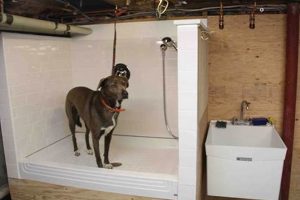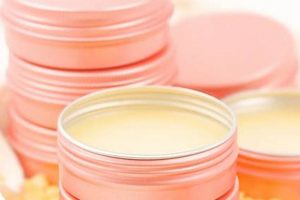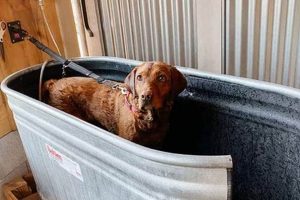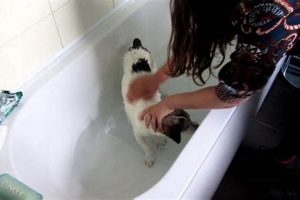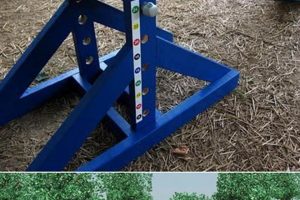Formulations designed to cleanse a canine’s coat without water, crafted within a domestic setting, represent a practical grooming alternative. These preparations typically consist of absorbent powders or mixtures intended to remove excess oil and dirt from the animal’s fur. An example includes combining cornstarch, baking soda, and essential oils to create a deodorizing and cleaning agent.
The significance of these homemade cleansers lies in their accessibility, cost-effectiveness, and potential to mitigate skin irritation associated with traditional bathing methods, especially for dogs with sensitive skin or those averse to water. Historically, alternatives to water-based bathing were employed to maintain hygiene in situations where water access was limited or when frequent washing was detrimental to the animal’s coat and skin health.
The subsequent discussion will delve into specific recipes, application techniques, safety considerations, and the comparative advantages and disadvantages associated with creating these types of cleansing formulations for canine use.
Guidance for Home-Prepared Canine Coat Cleansers
The following recommendations aim to optimize the effectiveness and safety of homemade dry cleansing agents for canines, promoting responsible grooming practices.
Tip 1: Ingredient Selection: Prioritize non-toxic, hypoallergenic ingredients. Common choices include cornstarch, baking soda, and finely ground oatmeal. Avoid substances known to cause irritation or allergic reactions in dogs.
Tip 2: Essential Oil Dilution: If incorporating essential oils for fragrance or purported therapeutic benefits, ensure proper dilution. A general guideline is one to two drops of essential oil per ounce of base powder (e.g., cornstarch). Consult a veterinarian regarding safe essential oil usage for canines.
Tip 3: Patch Testing: Before full application, conduct a patch test on a small area of the dog’s skin to check for adverse reactions. Observe the area for 24-48 hours for signs of redness, itching, or swelling.
Tip 4: Application Technique: Apply the dry cleanser sparingly, focusing on oily or dirty areas. Avoid the dog’s eyes, nose, and mouth. Gently massage the powder into the coat, working against the direction of hair growth.
Tip 5: Removal Process: Thoroughly remove the dry cleanser from the coat using a brush or comb. Multiple passes may be necessary to eliminate residue. Consider using a low-setting hair dryer (on cool) to aid in powder removal.
Tip 6: Frequency of Use: Employ these cleansers judiciously. Excessive use may lead to skin dryness or irritation. Limit application to when traditional bathing is impractical or contraindicated.
Tip 7: Storage Considerations: Store any unused homemade product in an airtight container in a cool, dry place. Label the container clearly with the ingredients and date of preparation.
Adherence to these guidelines promotes responsible and effective utilization of DIY canine coat cleansing agents. Prioritizing safe ingredients and application techniques minimizes potential adverse reactions and supports canine hygiene.
The subsequent section will address potential risks and benefits associated with various homemade recipes, enabling informed decision-making regarding canine grooming practices.
1. Ingredient Selection
Ingredient selection constitutes a foundational aspect of “dry shampoo for dogs diy.” The chosen components directly determine the efficacy, safety, and suitability of the final product. For example, utilizing food-grade ingredients minimizes the risk of adverse reactions should the canine ingest the product during grooming. Conversely, incorporating abrasive substances or known allergens can lead to skin irritation, discomfort, or even allergic reactions. Therefore, the cause-and-effect relationship between ingredient choice and the outcome is unequivocal. The purpose of the dry shampoo is to absorb oils and dirt without harming the animal.
The careful selection of ingredients is paramount for “dry shampoo for dogs diy” in addressing specific canine needs. A dog with sensitive skin benefits from a formulation containing colloidal oatmeal, known for its soothing properties. Another common ingredient, baking soda, acts as a deodorizer, counteracting unpleasant smells that can accumulate in a dog’s coat. Cornstarch serves as a primary absorbent, drawing excess oil from the fur. These elements combined are an option for maintaining hygiene in between full baths, especially for dogs that dislike water or are prone to skin issues from frequent washing. The chosen ingredients must therefore also be finely ground to prevent irritation or clogging of pores.
In conclusion, ingredient selection is not merely a preparatory step in “dry shampoo for dogs diy,” but rather the cornerstone of its success or failure. Neglecting this aspect can result in an ineffective or even harmful product. Prioritizing non-toxic, hypoallergenic components tailored to the specific needs of the canine promotes safe and effective coat maintenance. The challenges in ingredient selection are the knowledge needed to do it right, and to stay informed about the dog’s condition to adjust the shampoo for that. A well-considered recipe supports the larger goal of responsible canine care.
2. Preparation Method
The preparation method for homemade canine coat cleansers directly influences the final product’s efficacy and safety. Deviation from established protocols in “dry shampoo for dogs diy” can lead to a formulation that is either ineffective at removing dirt and oil or, worse, harmful to the animal’s skin. For example, insufficient mixing of ingredients, such as clumping of cornstarch, can result in uneven application and reduced absorption. Conversely, excessive grinding or blending of certain materials, like oatmeal, may alter their particle size, potentially causing irritation. The specific instructions within a given recipe therefore act as critical controls, guiding the process towards a safe and functional outcome. Precise measurement and adherence to the correct sequence of combining components are crucial steps in achieving the intended effect.
The preparation method’s importance extends beyond mere ingredient combination. It also dictates the product’s homogeneity and stability. A well-executed method ensures uniform distribution of essential oils (if included), preventing concentrated areas that could cause skin reactions. Furthermore, the process can impact shelf life; improper storage due to inadequate preparation can lead to bacterial growth or degradation of active ingredients, compromising the cleanser’s integrity. As an example, a poorly sealed container post-mixing can expose the formulation to moisture, fostering mold or mildew growth. A meticulously documented and consistently followed method is thus imperative for creating a reliable product that meets safety and performance expectations.
In conclusion, the preparation method is not a trivial adjunct to “dry shampoo for dogs diy,” but an integral determinant of its success. Improper execution can negate the benefits of carefully selected ingredients, potentially resulting in an ineffective or even detrimental outcome for the animal. The challenges within proper preparation is the amount of time that is used, and some ingredient may be too expensive, but in the end, a meticulously planned and rigorously executed method assures a safe and reliable homemade cleaning agent for canine use, supporting responsible animal care practices and hygiene.
3. Application Safety
Application safety is a paramount consideration when utilizing homemade dry cleansing agents for canines. The potential for adverse reactions or unintended consequences necessitates a cautious approach. Proper application techniques and awareness of potential hazards are critical for safeguarding the animal’s well-being during the grooming process.
- Avoiding Sensitive Areas
The formulation should be meticulously kept away from the canine’s eyes, nose, and mouth. Ingestion can lead to gastrointestinal distress, while contact with the eyes can cause irritation or even corneal damage. Careful application, focusing on the coat and avoiding these sensitive regions, is essential to prevent such complications.
- Ventilation Considerations
Application should occur in a well-ventilated area. The inhalation of fine powders, particularly those containing essential oils or other volatile compounds, can irritate the respiratory system. Adequate ventilation minimizes the risk of respiratory distress for both the animal and the person administering the cleanse.
- Monitoring for Adverse Reactions
Close observation of the canine during and after application is necessary to detect any signs of adverse reaction. Symptoms such as excessive scratching, redness, swelling, or difficulty breathing warrant immediate cessation of the process and consultation with a veterinarian. Early detection and intervention are critical for mitigating potential harm.
- Patch Testing Protocol
Prior to full application, a patch test should be conducted. A small amount of the dry cleanser is applied to a discreet area of the canine’s skin, and the area is monitored for 24-48 hours. This process allows for the identification of potential allergic reactions or sensitivities before widespread application, minimizing the risk of significant adverse events.
The various facets of application safety are interconnected and equally critical for the responsible use of homemade dry cleansing agents. By adhering to established safety protocols and diligently monitoring the animal’s response, the risks associated with this grooming practice can be significantly reduced. The ultimate objective is to maintain canine hygiene without compromising the animal’s health and well-being.
4. Coat Compatibility
Coat compatibility represents a fundamental consideration in the domain of “dry shampoo for dogs diy”. The diverse range of canine coat types necessitates careful formulation and selection of ingredients to ensure effective cleansing without causing irritation or damage. Factors such as coat length, density, texture, and the presence of underlying skin conditions all influence the suitability of a given homemade dry shampoo.
- Coat Length and Powder Residue
Long-haired breeds are particularly susceptible to powder residue accumulation following application of dry shampoo. The dense fur can trap particles, leading to matting, irritation, or a dull appearance. Diligent brushing after application is crucial to remove excess powder. Alternatively, formulations utilizing finer powders or liquid-based dry shampoos may be better suited for these coat types.
- Coat Texture and Absorbency
Wire-haired breeds, with their coarse texture, may require formulations with enhanced absorbent properties to effectively remove oils and dirt. Ingredients such as fuller’s earth or charcoal powder can provide superior cleansing for these coat types. Conversely, smooth-coated breeds may be adequately cleansed with milder formulations based on cornstarch or baking soda.
- Skin Sensitivity and Irritation Potential
Canines with sensitive skin or pre-existing dermatological conditions require formulations that minimize the risk of irritation. The use of hypoallergenic ingredients, such as colloidal oatmeal or chamomile, is recommended. Fragrance-free options are also advisable to avoid potential allergic reactions. Patch testing prior to full application is essential to assess individual tolerance.
- Double-Coated Breeds and Distribution Challenges
Double-coated breeds present a unique challenge due to the presence of a dense undercoat. Effective distribution of the dry shampoo throughout the coat requires careful application and massage. Parting the fur in sections and applying the product directly to the skin can improve penetration. Regular brushing after application is essential to prevent matting and ensure thorough removal of the product.
These facets underscore the critical relationship between coat type and the selection of appropriate ingredients and application techniques in “dry shampoo for dogs diy”. A generalized approach to dry shampoo formulation can result in suboptimal cleansing or adverse skin reactions. By tailoring the formulation and application method to the specific characteristics of the canine’s coat, pet owners can achieve effective and safe hygiene maintenance, minimizing potential discomfort or harm.
5. Storage Stability
Storage stability directly impacts the efficacy and safety of “dry shampoo for dogs diy.” Improper storage can degrade active ingredients, promoting microbial growth and rendering the product ineffective or even harmful. The composition of these homemade formulations, often lacking synthetic preservatives, makes them particularly susceptible to environmental factors such as moisture, temperature fluctuations, and light exposure. For instance, a dry shampoo containing baking soda, if exposed to humidity, can absorb moisture and clump, altering its texture and reducing its ability to effectively absorb oils from the dog’s coat. Similarly, essential oils, if not stored in airtight, dark containers, can oxidize and lose their fragrance and therapeutic properties, impacting the intended deodorizing and soothing effects.
Effective storage practices are therefore crucial for maintaining the integrity of “dry shampoo for dogs diy.” Recommendations include storing the product in airtight containers, preferably made of opaque materials, in a cool, dry, and dark location. The containers should be clearly labeled with the date of preparation and a list of ingredients. Failure to adhere to these practices can lead to several adverse outcomes. For example, microbial contamination can cause skin irritation or infections in the canine. Degradation of ingredients can diminish the cleansing and deodorizing capabilities of the product, rendering it ineffective. Moreover, the presence of clumps or a change in texture can make application difficult and uneven, potentially leading to skin irritation.
In conclusion, storage stability is an indispensable component of “dry shampoo for dogs diy.” Improper storage not only compromises the product’s efficacy but also poses potential health risks to the animal. By implementing appropriate storage protocols, pet owners can ensure that their homemade dry shampoos remain safe, effective, and contribute to responsible canine hygiene. The challenge is maintaining these stringent processes, but attention to the details ensures the formulation retains its intended cleaning properties over a defined period.
Frequently Asked Questions
This section addresses common inquiries regarding the formulation, application, and safety of homemade dry cleansing agents for canines. The following questions and answers aim to provide clear and informative guidance on this topic.
Question 1: Are all ingredients safe for canine use?
No, not all ingredients commonly found in household products are safe for canine use. Certain essential oils, fragrances, and chemical compounds can be toxic or irritating to dogs. Thorough research and veterinary consultation are recommended before incorporating any ingredient into a homemade dry shampoo formulation.
Question 2: How frequently can dry shampoo be applied?
The frequency of application depends on several factors, including the dog’s breed, coat type, activity level, and underlying skin conditions. As a general guideline, dry shampoo should be used sparingly, typically no more than once or twice per week, to avoid stripping the coat of its natural oils and causing dryness or irritation.
Question 3: Can dry shampoo replace traditional bathing?
Dry shampoo is not a complete substitute for traditional bathing. While it can effectively remove surface dirt and oil, it does not provide the same level of deep cleansing or sanitization as a water-based bath. Dry shampoo is best used as a supplement to regular bathing, particularly for dogs that are averse to water or have medical conditions that limit their ability to tolerate frequent bathing.
Question 4: What are the signs of an adverse reaction to dry shampoo?
Signs of an adverse reaction to dry shampoo can include excessive scratching, redness, swelling, hives, difficulty breathing, vomiting, or diarrhea. If any of these symptoms occur, discontinue use immediately and consult with a veterinarian.
Question 5: How should dry shampoo be stored to maintain its efficacy?
Dry shampoo should be stored in an airtight container in a cool, dry, and dark place. Exposure to moisture, heat, or light can degrade the ingredients and reduce the product’s effectiveness. Properly stored dry shampoo can typically remain effective for several months.
Question 6: Can dry shampoo be used on puppies?
The use of dry shampoo on puppies requires caution. Puppies have more sensitive skin than adult dogs and are more susceptible to adverse reactions. If dry shampoo is used on a puppy, it should be specifically formulated for sensitive skin and applied sparingly. Consultation with a veterinarian is recommended prior to using any dry shampoo on a puppy.
The information presented addresses key concerns regarding the safe and effective use of homemade dry shampoo for canines. Careful consideration of these factors is essential for responsible grooming practices.
The following section will provide a detailed step-by-step guide for creating a basic homemade dry shampoo formulation.
Conclusion
The preceding exploration of “dry shampoo for dogs diy” has illuminated the multifaceted considerations inherent in this grooming practice. Key aspects addressed encompass ingredient selection, preparation methodology, application safety, coat compatibility, and storage stability. Adherence to established protocols and a thorough understanding of canine physiology are essential to mitigating potential risks and maximizing the efficacy of homemade dry cleansing agents.
The responsible implementation of these principles will contribute to the well-being of canine companions. The potential benefits of cost-effectiveness and reduced chemical exposure necessitate a commitment to diligent research and informed decision-making. Further investigation into species-specific dermatological needs and ingredient interactions remains crucial for advancing the safety and efficacy of “dry shampoo for dogs diy” formulations.


